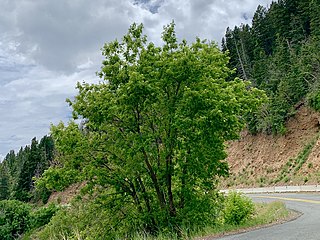
Acer negundo, the box elder, boxelder maple, Manitoba maple or ash-leaved maple, is a species of maple native to North America. It is a fast-growing, short-lived tree with opposite, compound leaves. It is sometimes considered a weedy or invasive species, and has been introduced to and naturalized throughout much of the world, including in South America, Australia, New Zealand, South Africa, much of Europe, and parts of Asia.

Vitex negundo, commonly known as the Chinese chaste tree, five-leaved chaste tree, or horseshoe vitex, or nisinda is a large aromatic shrub with quadrangular, densely whitish, tomentose branchlets. It is widely used in folk medicine, particularly in South and Southeast Asia.

Vērmane Garden is the oldest public garden in the city of Riga, Latvia, and currently comprises an area of approximately 5 hectares. The current name is a Latvian transliteration of the garden's original German name.

Isoorientin is a flavone, a chemical flavonoid-like compound. It is the luteolin-6-C-glucoside. Bioassay-directed fractionation techniques led to isolation of isoorientin as the main hypoglycaemic component in Gentiana olivieri. Studies also showed that isoorientin is a potential neuroprotective compound against Alzheimer's disease.

Cryphia ochsi is a moth of the family Noctuidae. It is found in the Central and Eastern part of the Mediterranean Basin. In the Levant it has been recorded from Lebanon and Israel.
Acer negundo 'Pendulum', or weeping boxelder maple, is a weeping tree and a cultivar of Acer negundo, the boxelder maple. It was first described by Fritz Kurt Alexander von Schwerin in 1896. No trees are known to survive of this cultivar.

Pogonocherini is a tribe of longhorn beetles of the subfamily Lamiinae.
Poliaenus is a genus of longhorn beetles of the subfamily Lamiinae, containing the following species:
Poliaenus abietis is a species of beetle in the family Cerambycidae. It was described by Tyson in 1968. It is known from the United States.
Poliaenus batesi is a species of beetle in the family Cerambycidae. It was described by Linsley in 1933. It is known from Guatemala.
Poliaenus californicus is a species of beetle in the family Cerambycidae. It was described by Schaeffer in 1908. It is known from the United States.
Poliaenus concolor is a species of beetle in the family Cerambycidae. It was described by Schaeffer in 1909. It is known from Baja California.
Poliaenus hesperus is a species of beetle in the family Cerambycidae. It was described by Chemsak and Linsley in 1988. It is known from Mexico.
Poliaenus nuevoleonis is a species of beetle in the family Cerambycidae. It was described by Chemsak and Linsley in 1975.
Poliaenus obscurus is a species of beetle in the family Cerambycidae. It was described by Fall in 1910.
Poliaenus oregonus is a species of beetle in the family Cerambycidae. It was described by John Lawrence LeConte in 1861. It is known from North America.
Poliaenus sparsus is a species of beetle in the family Cerambycidae. It was described by Chemsak and Linsley in 1975. It is known from Mexico.
Poliaenus volitans is a species of beetle in the family Cerambycidae. It was described by John Lawrence LeConte in 1873. It is known from Guatemala and Mexico.
Acer eonegundo is an extinct maple species in the family Sapindaceae described from a single partial fossil leaf. The species is known from Eocene sediments exposed in the US state of Nevada. It is placed into the living Acer section Negundo.





